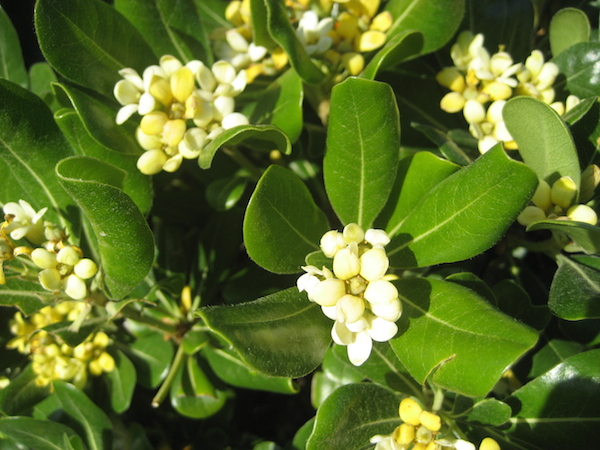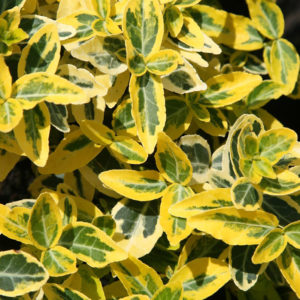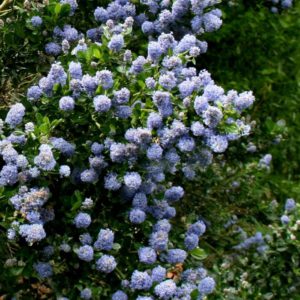Pittosporum tobira ‘Nana’ / Japanese Mock Orange
Price range: €25.00 through €125.00
Frequently Bought Together


Description
Quick Facts
- Common Name: Dwarf Japanese Mock Orange, Dwarf Japanese Pittosporum, Compact Mock Orange
- Botanical Name: Pittosporum tobira ‘Nana’ (syn. ‘Nanum’)
- Plant Type: Evergreen shrub
- Mature Height: 60cm-1m
- Mature Spread: 1-1.5m
- Flowering Period: May to June
- Flower Colour: Creamy-white, intensely fragrant
- Foliage: Glossy, deep green, leathery obovate leaves
- Hardiness: RHS H3-H4 (hardy in milder areas, needs protection in cold regions)
- Soil Requirements: Well-drained, fertile soil; tolerates most soil types
- Aspect: Full sun to partial shade; sheltered position
- Maintenance: Low
Description
Experience the breathtaking beauty of Pittosporum tobira ‘Nana’, the perfect compact evergreen shrub for creating year-round structure and intoxicating late spring fragrance in gardens, where naturally rounded form, lustrous deep green foliage, and honey-scented white flowers combine to bring Mediterranean elegance and sensory delight to borders, containers, and coastal gardens. This exceptional cultivar offers remarkable qualities—compact naturally rounded habit growing to just 60cm-1m tall with 1-1.5m spread creating perfect low mounds without pruning making it ideal for small gardens and containers, lustrous deep green leathery leaves with rounded spatulate shape providing year-round glossy evergreen structure and architectural presence, clusters of intensely fragrant creamy-white flowers in late spring filling gardens with sweet orange blossom scent that perfumes the air and attracts pollinators, exceptional drought tolerance once established making it perfect for low-maintenance gardens and Mediterranean-style plantings, and outstanding coastal tolerance withstanding salt spray and maritime conditions where many plants struggle, making this one of the most versatile and rewarding choices for adding compact evergreen structure, intoxicating fragrance, and Mediterranean character to borders, containers, coastal gardens, and low-maintenance plantings where its naturally neat form and glossy foliage create year-round impact with minimal care.
Throughout the seasons, this captivating shrub displays its characteristic compact rounded form—naturally developing into perfect dense mounds without any pruning required, creating neat architectural presence ideal for formal and informal gardens alike. The lustrous deep green leaves are arranged in whorls at branch tips, each leaf measuring 4-8cm long with distinctive obovate (reverse egg) shape, rounded tips, and leathery texture with glossy surface that reflects light beautifully creating jewel-like quality. The foliage remains pristine and glossy throughout the year providing reliable evergreen structure and backdrop. In late spring to early summer (May-June), the branch tips become adorned with terminal clusters (umbels) of small creamy-white flowers measuring 1-1.5cm across—each cluster holds 20-30 individual flowers creating generous displays. The flowers are the true glory of this plant—their intense sweet fragrance resembles orange blossom with honey undertones, perfuming the entire garden and drawing you close to appreciate their intoxicating scent. The fragrance is particularly strong in warm weather and evening hours, creating magical sensory experience. Following flowering, small woody capsules develop containing sticky orange seeds (hence the common name ‘Pittosporum’ from Greek ‘pitta’ meaning pitch and ‘sporum’ meaning seed). The overall effect is elegant, refined, and Mediterranean—like having a piece of coastal paradise in your garden. The compact naturally rounded form requires no pruning to maintain shape, making this perfect for low-maintenance gardens where neat structure is desired without constant intervention.
Native to coastal areas of southern Japan, Korea, and China where it grows naturally on rocky slopes and coastal cliffs, Pittosporum tobira has been cultivated in gardens for centuries and is beloved for its fragrant flowers, glossy foliage, and coastal tolerance. The species name ‘tobira’ is the Japanese name for the plant. The cultivar ‘Nana’ (also sold as ‘Nanum’) was selected specifically for its compact dwarf habit—growing to just one-third the size of the species which can reach 3-4m tall, making this cultivar perfect for smaller gardens, containers, and formal plantings where compact size is essential. Slow to moderate growth rate, adding 10-20cm annually once established, reaching mature compact size within 5-7 years. Hardy to RHS H3-H4, this shrub thrives reliably in milder coastal areas and sheltered gardens in southern and western regions, though requires protection from severe frosts and cold winds in colder areas—ideal for coastal gardens, sheltered urban gardens, and mild temperate climates. In colder regions, grow in containers and move to frost-free protection during winter, or plant against warm south or west-facing walls with winter fleece protection. Particularly valuable for exceptional coastal tolerance—withstands salt spray, maritime winds, and sandy soils making it perfect for seaside gardens where many plants struggle. Also tolerates urban pollution, drought once established, and poor soils. The compact naturally rounded form makes this outstanding for formal gardens, low hedging, edging, containers, and anywhere neat compact evergreen structure is desired. Excellent in Mediterranean-style gardens where its glossy foliage, fragrant flowers, and drought tolerance fit perfectly with the aesthetic.
Create stunning compositions by planting as compact evergreen structure in mixed borders where its naturally rounded form provides year-round architectural presence and glossy foliage creates backdrop for perennials and seasonal colour, using as low informal hedging or edging along pathways and borders where its compact habit creates neat definition without overwhelming smaller plants, or positioning in coastal gardens where its exceptional salt tolerance and wind resistance excel and glossy foliage brings structure to challenging maritime conditions. Exceptional in Mediterranean-style gardens combined with lavenders (Lavandula), rosemary (Rosmarinus), cistus, santolina, and ornamental grasses for authentic sun-loving drought-tolerant plantings with complementary textures and fragrances, formal gardens where its naturally rounded form creates perfect geometric shapes for parterre-style plantings or repeated accents, or contemporary minimalist gardens where its neat compact mounds provide sculptural evergreen presence against gravel, paving, or rendered walls. Works beautifully planted in generous containers (minimum 40-50cm diameter) for patios, entrance areas, and balconies where its compact size, glossy foliage, and fragrant flowers create welcoming statement and can be positioned to enjoy the intoxicating scent up close, as single specimens where each plant develops perfect rounded form, or in groups of three or five for rhythmic repetition and greater impact. Also magnificent combined with silver-leaved plants like artemisia, stachys, or helichrysum for textural contrast, purple-leaved heucheras or berberis for colour contrast, or planted beneath roses where its evergreen structure provides year-round interest after roses finish flowering. Perfect for adding compact evergreen structure, intoxicating fragrance, and Mediterranean character to borders, containers, coastal gardens, and low-maintenance plantings where its naturally neat form and glossy foliage create year-round impact with minimal care.
Caragh Garden Notebook
Planting: Space shrubs 1-1.5m apart for individual specimens or low informal hedging, allowing room for mature spread. Plant container-grown specimens year-round in mild areas, though spring (April-May) or early autumn (September) is ideal for best establishment before winter. Choose position in full sun to partial shade—best flowering and compact growth occur in full sun, but tolerates partial shade with slightly reduced flowering. Requires well-drained soil—avoid waterlogged or heavy wet soils which cause root rot, particularly in winter. Prefers sheltered position protected from cold drying winds and severe frosts—ideal positions include south or west-facing borders, sheltered courtyards, coastal gardens with natural wind protection, or against warm walls in colder areas. In colder regions (below -5°C regularly), plant against warm walls with winter protection or grow in containers that can be moved to frost-free shelter. Dig generous planting hole twice width of root ball and same depth. Incorporate organic matter (well-rotted compost) and grit or sharp sand to improve drainage, particularly in heavy soils. Plant at same depth as in container—avoid planting too deeply. Water thoroughly after planting and apply 5cm mulch of gravel, grit, or bark around base, keeping mulch clear of stems. Water regularly during first growing season to establish deep root system. Position where the fragrant flowers can be appreciated—near pathways, seating areas, or entrances where the intoxicating orange blossom scent can be enjoyed.
Soil Preparation: Tolerates wide range of well-drained soil types including sandy, loamy, chalky, and even poor soils, but performs best in fertile, well-drained soil. Prefers neutral to slightly alkaline pH (6.5-8.0) but adapts to most garden soils. CRITICAL: Requires excellent drainage—avoid waterlogged, heavy clay, or wet soils which cause root rot and plant decline, particularly in winter. Improve heavy clay soils by incorporating generous amounts of grit or sharp sand (at least one-third by volume) and organic matter to improve drainage and structure. Sandy soils benefit from added organic matter to improve moisture retention and fertility, though drainage is naturally good. Tolerates drought once established—deep watering during establishment is important, but mature plants require minimal watering. Tolerates coastal conditions including salt spray and sandy soils. Mulch with gravel or grit in spring to suppress weeds and improve drainage around base. Best growth and flowering occur in full sun with well-drained, fertile soil and shelter from severe frosts and cold winds.
Container Growing: Outstanding in containers for patios, entrance areas, balconies, and in colder regions where plants can be moved to frost-free protection during winter. Use containers minimum 40-50cm diameter and depth with excellent drainage holes. Use well-drained soil-based compost (John Innes No. 2 or 3) mixed with additional grit or sharp sand (one-third by volume) to ensure excellent drainage. Position in full sun to partial shade in sheltered location. Water regularly during growing season allowing compost to dry slightly between waterings—avoid overwatering which causes root rot. Container-grown plants need more frequent watering than those in ground, particularly during hot weather, but ensure containers never sit in water. Feed monthly April-September with balanced liquid fertiliser or apply slow-release fertiliser in spring. In colder regions, move containers to frost-free greenhouse, conservatory, or sheltered porch during winter (October-April), or wrap pots with bubble wrap and protect foliage with fleece if left outdoors. Top-dress annually in spring by removing top 5cm of compost and replacing with fresh compost mixed with slow-release fertiliser. Repot every 3-4 years in spring into slightly larger container, or root-prune and return to same pot to maintain compact size. Container specimens can be maintained at smaller size through light pruning after flowering.
Seasonal Care: Requires minimal pruning—the naturally compact rounded form develops without intervention. Prune lightly after flowering (June-July) if needed to maintain shape or control size, though this is rarely necessary—the dwarf habit naturally creates perfect mounds. Remove any dead, damaged, or frost-damaged growth in spring. Can be clipped into formal shapes if desired, though this may reduce flowering as flower buds form on previous season’s growth. Apply general-purpose balanced fertiliser or blood, fish and bone in spring to promote healthy growth and flowering. Mulch with gravel or grit. Water regularly during first two growing seasons to establish deep drought-tolerant root system—once established, plants tolerate drought well and require minimal watering except during prolonged dry spells. In colder regions, protect from severe frosts below -5°C with horticultural fleece or move containers to frost-free shelter—established plants in sheltered positions in milder areas rarely need protection. Watch for aphids on new growth (spray with water or insecticidal soap) and scale insects on stems (remove by hand or treat with horticultural oil). Generally pest and disease free with proper drainage and positioning. Foliage may suffer damage in severe winters—remove damaged growth in spring and plant will regenerate. The fragrance is reliably intoxicating and the compact form requires minimal maintenance!
Propagation: Can be propagated from semi-ripe cuttings taken in late summer (July-August) with moderate success rate. Take 8-10cm cuttings from current season’s growth, remove lower leaves, dip in rooting hormone, and insert into pots filled with very free-draining compost (50:50 compost and perlite or sharp sand). Keep in sheltered position with bottom heat if possible. Rooting takes 8-12 weeks. Pot on individually once rooted and grow on in frost-free conditions for full season before planting out. Can also be propagated from seed, though germination is slow and erratic, and seedlings take many years to reach flowering size. Home gardeners can propagate this cultivar, though nursery-grown specimens provide more immediate compact impact and guaranteed flowering size.
This spectacular beauty is absolutely breathtaking—one of the most perfectly compact evergreens available! That naturally rounded dwarf habit growing to just 60cm-1m tall with 1-1.5m spread is absolutely perfect—creating neat mounds without any pruning required! Lustrous deep green glossy leathery foliage providing year-round structure, clusters of intensely fragrant creamy-white flowers in late spring filling gardens with intoxicating sweet orange blossom scent that perfumes the air—absolutely divine! Slow-growing and naturally compact making it perfect for small gardens and containers. Exceptional coastal tolerance withstanding salt spray and maritime winds, outstanding drought tolerance once established. Hardy in milder areas and sheltered gardens—needs protection from severe frosts below -5°C in colder regions, perfect in containers that can be moved to shelter. Perfect for Mediterranean gardens, coastal plantings, formal gardens, containers, low hedging, and anywhere you want compact evergreen structure with intoxicating fragrance and minimal maintenance. Pure Mediterranean elegance and sensory delight!





